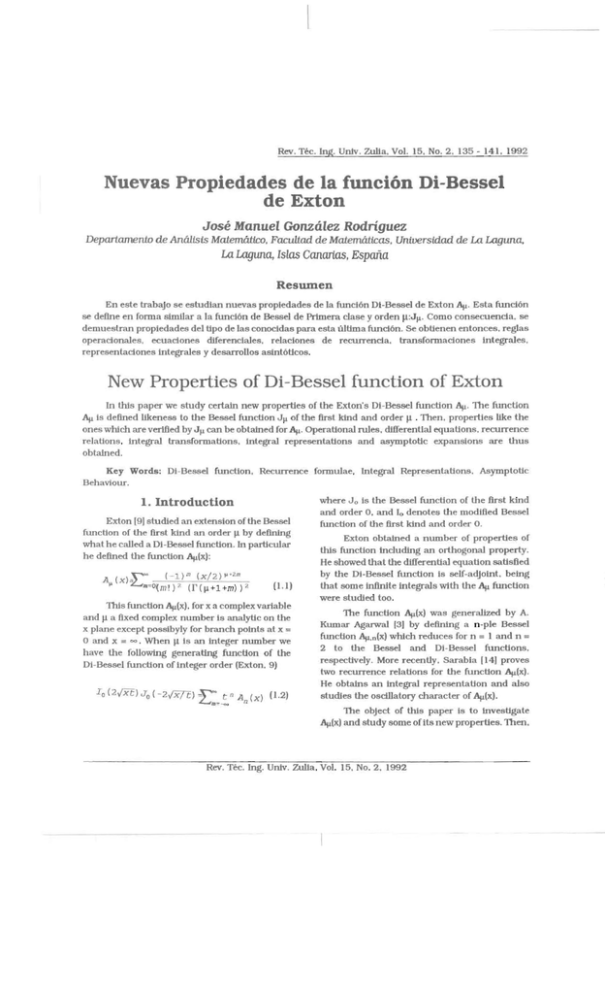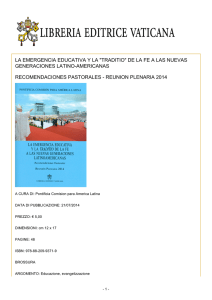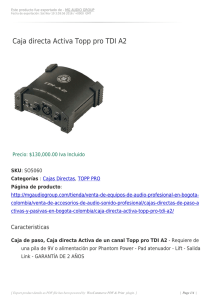Nuevas Propiedades de la función Di
Anuncio

Re\'. Téc. Ing. UnJv. Zulla. Vol. 15. No. 2 . 135 - 141. 1992
Nuevas Propiedades de la función Di-Bessel
de Exton
José Manuel González Rodríguez Departamento de AnálIsis Matemático, Facultad de Matemáticas. Untverstdad de La. Laguna. La LagWla, Islas Canarias, España Resumen
En este trabajo se estudian nuevas propiedades de la fundón D1-BesseJ de Exton Aj,t. Esta fundón
se define en forma slnúlar a la función de Bessel de Primera clase y orden Il:JI1 . Como consecuenda. se
demuestran propiedades del tipo de las conocidas para esta Ultima fundón. Se obtienen entonces. reglas
operacionales. ecuaciones diferenciales. relaciones de recurrenda. transformaciones Integrales.
representaciones integrales y desarraUoa asintóticos.
New Properties of Di-Bessel function of Exton
In thJs paper we study certain new properties of the Exton's Di-Bessel function Aj,t . The fIDlction
.t\!ls deOned Ukeness to the BesaeI function Jf.1 of fue first klnd and order Il . Then. propertles like the
ones which are vertfted by JI! can be obtalned for A,.t. Operatlonal rules. differential equatlons. reClUTence
relationa . Integral lransformations. Integral representations and asymptotlc expanslons are thus
obtained.
Key Words: DI-Bessel functlon. Recurrence formulae . Integral Representationa. Asymptotic
Behaviour.
l. Introduction
Exton L9) studled an exten510n ofthe Bessel
functlon of the Orat kind an order Il by deflnlng
what he called a D1-Bessel function. In particular
he defined the functlon A,.t(x):
A (xlL
lO
( - l )m (x/2) .. ·zm
JII:O(m!) "
(r{Jl +l+m )) 7.
(1.1)
1his function .t\!(x). for x a complex variable
and Il a flxed cornplex: number la anaIyt1c on the
x plane except posslbyly for branch polnt.s al x =
O and x = oo . When J1 J5 an Integer numher we
have t.be foUowtng generatlng CuncHon of the
Di-Bessel Cunctlon of tnteger order (Exton. 9)
where Jo is the Bessel functlon of fue first kind
and order O. and lo denotes ilie modified Bessel
runctlon of fue first kind and order O.
Exton obtained a nUD1ber of propeTtles of
thJs fi.mction IncJuding an orthogonal property.
He showed that the diJJerentiaJ equatlon satlsfied
by ilie DI -Bessel functlon 15 self-adJotnt. belng
that sorne lnfinite lntegrals with the A,.t function
were studJed too.
The funcHon 1\!(x) was generallzed by A.
Agarwal [3) by defining a n-pIe Besse1
functlon A,.t.n(x) which reduces for n = 1 and n =
2 to the Besael and Di-Bessel functlons.
respectiveJy. More recenUy. Sarabía 114) proves
two recurrence relatlons for tbe functlon 1\!(x).
He obtalns an integral representation and a1so
studles ilie oscl.Oatory character of ~(x) .
Kumar
The object of thJa paper la to Investlgate
Aj,t(x) and study sorne ofilsnewproperties. Then.
Rev. Téc. lng. UnJv. Zulla. Vol. 15. No . 2. 1992
González Rodriguez
136
as the Dl-Bessel functlon appears as a particular
case oC the hyper-Bessel functions (Delerue. [4):
DlmovskHiliyakova. 15): Adamch1k. 11) a good
number of propertles of the functlon ~ can be
proved. In particular. we obtatn in lhis paper
sorne d1fI'erenlial equatlons whicb are verlfted for
odlfted verstons oC the Dt-Bessel funcüon: we
study two new recurrence re1atlons for ~:
spectal defutlte integrals for ~ are also obtained:
an Integral representation of fue Dl-6essel
functlon is Ukewise found. LasUy we present the
asymptoUc expansiona of the Att functlon.
The present papee wUI be conUnued tn a
new work where we will define a new IntegraJ
ansformaUon of the Hankel type which
contaJns the Di-Bessel funcHon Att in its kernel.
Then lnversion fonnulae. convergence Oleorems.
and spaces of test funcUons where thls
transfonnatlon will iN: a llnear and contlnuous
mapptng w1l1 be studled.
( -x)-~/2
1
J. 6
(O - ~}2. (O+~}2[AII(U}J
X ~
( - x) -,,/2
(2i.[X)
=
(2iy'X)
In tbIs way we have proved that the
functlon A,.t(x) saUsfies the operational equatlon:
When we choose the functlon Ba,~,¡J{x)
~(Kx~ for a constant K. K>O. we will find:
A .. (y)
=XU
== (y/K) a/IIB... ... (y/ K) 111' ; y>O
II
and belng that:
~ [fe (y/K) 1/11)] :; «(3 1tl(f) ( (Y/K) 1/11)
for ( a regular function: we will obtaIn:
2. Differentlal Equatlons
On lnvesHgatlng differenUal equatlons
assodated with Ole DI-Be~ funcHon. we begin
wilh fue operaUonaJ equaUon:
and so we can flnd the operatlonaJ relation :
where
~ ==
X
d
dx and x
> OlA >
O
_y2P 4 K 2 B
wb1ch is saUsfied by lhe functlon:
El' (AX)
=
P=
( - AX) - ,, / 2 Al' (2iv'lX)
· .11 ."
(y)
R4
~
(2.3)
In particular. when we choose a = 1/:1.. auu
l. we obtain:
(A.K. AgarwaJ. (3J. p . 142).
But. betng that: O {x«Xr{x)J
(2.3)
x a
(O + a) f(x). for f a regular
=
functlon and:
and as:
(6+"() (6+p)
we wIll find tltat:
1I 2
(O+~)2 ( - x)-1I / 2
=(-1 )
-1l/ 2
-\(2i/x)
( A .. (2i[X)
+ ("(+p)lI + ,,(P , fOI "(,p R
tbus:
=
X -"/2 (6 -Jl/ 2) (0 - Jl/2)
(6+JI/2) (6+J1/2)
= 62
=
[6
4
-
26 3
-
(211 2 - 3 / 2 )0 2 + 2(JI -l! 2) (~+1!2)6+
+ (JI+l/2)2 (JI - l/2)
-x 2
[4
K2
Rev. Téc. lng. Untv. Zulla, Vol. 15. No. 2. 1992
-\
"'Xv'XA" (Kx)]
(TOe)]
rx
=
Nuevas propiedades de la función Di-Bessel de Exton
Le.:
[X' ~, -
(~'-1/4)1 [X' ~, - (~'-1/4)1
[.¡x Al'
(Kx)] = - XZ 4 K[X A~ (x)
d7. 41J2 - 1
Furthermore, ifSI' = dx2'~ tt denotes the
137
Rllf( x) = r ( ~)
-1
fex
f ( t ) (X - t)
,, -1
dt,
(3.1)
for a regular function f,Ji > o. x > O, that: we know
1
r(n +1) R" [x" ] n E N, and IJ
Bessel's c1assical differentfal operator. we bave
>O
fOillld the followtng formula (2.4):
[s"
.¡x]
X S~
2
- 4 K2
[A~ (Kxll
lhen. being as:
=
A~ (Kx) )
(.[X
(_l)n (x/2) .. ·n
(1/2)"'1
( n! ) 7. [r ( JI +n + 1 ) ]2
9. Recurrence Formulae For At,t(x)
In thts seetlon we obtain eertain new
recurrenee relatlons ror the DI-Bessel hmetlon
~(x) . In Sarabia 14 we can ftnd the foUowing
Tecurrenee formulae ro[' this funetlon:
!x!
1.
2.
!
x
(x" A" (x ) ) ,= 2 x" A,, _l (x)
we have:
[(X/2)" A,,(X) ] (.¡x)
¿~..
co
R" [( -1 ) n (x/2 )
~
(x-"
~
n] (1 / 2) 2 I'+ n
(n!)3 r(~ +n + l)
n=O
!
=
) = -2 x·" A,,+l (x)
(x)
3.
~2A,,(x)
4.
+
5.
+
(1 - 21.¡)XA~(X)
A"~ (x)
X2
~2 A .. (x)
= -
2x A ,,' 1 (xl
+ (1 + 2~)XA~(x)
x 2 A l' (x) = 2 x A
..
6
(~ - 1) X2AI'+2(X)
+
"-1 ( xl
+ 2 ( ~ - 1) (~ + l l (21l~ 1)xA" '1(X )+
+ xl ) A" (x ) +
+ 2 .. ( 2117. (11 - 1) {Jl +ll
2 (~-1 ) (~ + 1 ) (1 - 21l ) xA,, - l (x)1 + ( ~+1)x A .. _ ~ (xl '" O
AddHionally. if we define the cUfferential
operatoTs 1\\1 and M~ by:
N
= X"' 1/2 ...si
,.
dx
=
M
..
we find that:
xZM. N
Il
X - .. - 1 / 2
...si
dx
=
Al' (x)
...si
- I' ­ 1 /2
dx x
X
X
( 2x )" RI' x -" RI'
[Aa ( /X) J
(x 2 )
(3.2)
4. Infinite lntegrals
...si x "+1 / 2
dx
Consider. first of alt, the integral
= X2
(XI' - 1 /2
...si
dx
j1
(X,,+ 1/ 2
'lhen we wilI havlO: obtaJned the general
formulae that follows:
...E.... x ...si
dx
dx
x
X- X - 1 / 2 )
...si
dx
=S
XI'+1 /2 )
[rx Al' (x) ] =
MI' [rx
{X} ]
Xl S
,,~
AI'+l
rx A .... (x) = 2 rx A" (x ) -2
=
J- e-IV( x· -
l
o
and then:
N..
I
l
A1so. 1f R¡.t denotes the Riemann-Uouville
operatoT (Ederly1, (S)) given 10 (3 . 1):
A (bx ) dx
"
Re a >O, Re(v+ll) >0
(4. I)
Re a > 0, Re(v + Jl) >O
lo Exton (9), p. 860 1t has been fotrnd lhat
"1" can be expressed In fue fonu:
a- V (b/2a)"
r(~ + v )
[ r(~ + 1}]2
~F]«v + ~}/2,
(v + Il +1 )/2;~+1,1l +1 , li - b~/a7.)
Rev. Téc. Ing. Unlv. Zulla. Vol. 15, No. 2. 1-992
(4.2)
/
138
González Rodríguez
Sarabta, [141, p. 72 obtalned an other
deflned integral for ~(x); but 1t ts not ofvel)' great
interest for usm. We are Interested in the
appllcatlon of some Integral transformatlons to
AJ¡(x). So. in (4.1)-(4.2) we can find the Laplace
transformation of ~. Then thts transformatlon
L(l\L(x»)(a) 18 gtven in (4.3):
5. Integral Representations 01 the Di-Bessel Function We
shall next examJpe various
representatlons of fue Di-Bessel fimctlon by a
system of definlte integrals and contour type
lntegrals. Ftrstly we ftnd the foUowtng integral
representatlon obtained by Sarabta, (141. p. 67:
L (A (x) ) (a) ~
II
J
=
xII
eS 21ti r(Il+1) 2~ e A (x)
(4.3)
11
r(Il+ 1 +2n )
( - 1/a 2 )n
¿n=o(n! ) 7. [ r(Il + 1 +n}]~
_ -1 "111
2-"a"
(5. 1)
Rea>O
where C denotes Hankel's contour.
Moreover. we know the byper-Bessel
funcUons deftned by Delerue. [41 In 1953 In fue
form:
When J.lls a nonnegative integer J.l = n EN.
tbe expresslon oC (5.1) will stay in the fono
(Exton. (9]. p. 857):
An ( x) = ~
f (~)'
27U
~1).2 .. .. A.-.
E
S -n-l Io (2.[XS>
(5.2)
where lo and Jo denote tbe classicaJ Bessel
funcUons of order O.
R. n E N . x >0
We now take into account Hankel's
weU-known Jntegral representaUon oC Bessel
ñmctions. and tben:
and being that Ap.(x) coincides wttb the funcUon:
A¡. (x) = Jo{.J~.1' (2.,f'2x:
7t
V/e find (Delerue, (4]. p . 233):
[r(!! + 1/2} ]2 2" ~
1: (-l)n (x/2)1"2n
L.Jrr=o n!) 7.
r (!! +n+l) ]
( - l )a
2 2n
=~
(t 2 -1,
= a",n JI'( ~~
P - l/Z
lP'O
f:
dx (4.8)
and we can obtaln an expUcit expression of (4.8)
when tbe Integral representaUon of Ap. ls known
which will be studied in tbe paragraph 5 .. .
(t 2 - 1)
'
1' - 1/2
n! )
dt
(
]7.=
r
t
2n
Jo
7.
'[2a ('[2-1) 1'-1/2 dT=
(2n! ) 2
=L.J"
M(A.. (x) ). (s) =
(2n!)
x"+ n i n
~
l4.7)
s 1
x - A .. (x)
f:
dt
='
2
r(n+I1+ 1 )
2 2n xl"2n (-l)n
(3a- l / 3 )
1be Mellin transfonoatlon M (Ap.)(s) of Ap.
will be gtven In the form:
[r(n+1/2) r(¡.¡ + /2)
xl'+2a
L.JIJ~
and so:
r
[ (2n) !]2
"....0
L (X - I'/2 A" ( ,[X/4) J (a)
Jo ( - 2..[XS> ds .
- e
f'
2
'[n
JI
-1
t
n n
('[2 - 1) "' - 1/2 d't
-1
Consider fue functlon obtatned by tnterchangtng tbe slgns of summatlon and IntegraUon on the rigbt; tt ls: where:
e
o
(z)=~
L.Jn-o
Rev. Téc.lng. Untv . Zulla. Vol 15. No. 2 . 1992
~
[n!J2
139
Nuevas propiedades de la'función Di-Bessel de Exton
denotes the Bessel-Cllfford functíon of the first
ldnd and order O (Hayek, (11))
>O
Re a
This Is an analytlc of x lor all values of x,
and when expanded 10 ascending powers of x by
MacLaurin's theorem. the coefficients may be
obtained by differentiatingwith regard to X under
tbe double integral sing and making x zero after
Le.; ~ will allow the new integral representation:
(O' ) e
A lO ( X ) = x _fl/2 _1_J
2 '
1tl
t
t-~-l L- 1
-­
diferentiation. Hence:
x~
f:
f~ Ca (- 2ix t t)
'= 1t
(tLl)
[ r(Il+ 1 !2 )J2 2~~"
L n=O
~-J/;> (t 2' -1) ~-1/1 dt dt
(_~) n (x! 2 ) .. ... 2n ;
l
(r ( 11 +1 +n) ) ,
(n ! )
(5.4)
=
LasUy. we can use the formula (5.3) to
obtain the Mellin rransformatlon of ~(x)
I,e .. the functlon l\t(x) admite the following
Integral representation (5.3):
A (x ) =
..
f1 f 1
(x!2) l'
[ r(Il+1 / 2 })2
1t
-1
[I-1l ('( L1 )
~ -1/2Co ( -2ixt't )
-1
d't ] d t ]dx
. ( x / 2) ~ n - 1 r ( Il +1 / 2 )
Co (-2 iXtT ) (t L 1 ) V - 1 /,- ('t l - 1 ) ,, -l!7. dtd'r
-2,
(5.3)
FurtheTlDore. by the fOTlDula (4,6) we
obtain:
and lntel'changing the Integration symbols. we shall obtain: M( A
( x )) (s)
~
2 - 1'
XI' /2 .;:( 3 )
1'. 1' .0
L- 1
[a-
=~
2n~
~
~n=O
inverse Laplace
.
!Cd-
=
r ( ll +m+1)
2n i
f­
0
M (A
~
(x)
2 - z ll - s i -I' - s
r(J.L +s)
;:;.-,--,----:-:0 -y;;";-:'-''---~
n(r ( jJ+1 /2)]2 f ( l - J.L - S )
(s ) = - = --
(5.5)
lO')
t~-m - l
e e dt
t describes the contour, we could carry out
caJculatlons analogous to the prevtous ones and
In that way obtaln:
11.11.
lo according
So: in which the phase of t lncreases froID -1t to 1t as
x~/ ' JIJ )
dt]dt
= 2 - ~"'1 2 2 ,,+7.S - 1 f ( ll + s )
n f(~ + 1 / 2)2 r ( l - Il - S )
R
_ 1_
o
Cor 3/2 > Re s > O.
Ditkln-ProudnJkov. (7). p. 359 da
So. U we take Hankel's weU-known
general1satlon of the second Eulenan integral:
1
[f.X";S-lJO(-2v'2~xtT ) dx]
e4X a - 2 1l / 3
(-1) n 3 n a - n/3
( n ! ) 2 r ( Il + D + 1 )
e
-1
( a~x )
e-l ­
for a real number c
(J 1(.. 2- 1) ~-1/2 . (4\1X) =
J2¿ (3 - -]y¿il 1
2 1'/]
1) ,,-1 / 2
-1
1t [ r(~ +1/2) J Z
and then. L-1 being the
Iransformatlon: we find:
=f 1(t L
(4~= _1_ fcd-e4xa-/.1' / 3
2ni e -l.
J3
( 11 +1/ 2, 1/2-1l/2-s/2) (1 + ( 1) ~<S)
/2
Then. we shall obtain:
M( A,, (x») (8)
= 1t-1 2 -2-2~ - S
r(J.L+S )
(- 1) -I¡><s)/2
f« (l- lI-s )/ Z )
r(l - IJ-S ) f ( 1+1l / 2 - S/ 2 )
.
r (1/ 2 - 1I / 2 - s ! 2 )
f (1 +1l!2 - s / 2 )
fol' 3/2> Re s > O and J.l >- 1/2,
Rev. Téc. lng. Univ. Zulla. Vol. 15. No. 2. 1992
( l+(-l)~ ·S )"
140
Goozález Rodriguez
Moreover. the followtng relations are
known:
(6.1)
Then, tl 18 posible to use the theorems
about tbe asymptotic expansions of Meyer's
ftmction in MathaJ-Saxena (12): 4> 1.8. lo obtaln that: and
..
" there ex1st constants: MI. M2..... Mn .... and; ( - 1) - (~ ls1/ 2 [1 -1-(- 1 ) ~·s1 2 = 4 cOS ( ¡.t. +s)rc / 2
G¿:~ [Z/O.O.-II.-..]-
L
(-21ti)- 3
i.. -1
then:
e2~lIi
M(A p (x ) ) (s) =x- 1 2-S -7." cos (¡.t. +s) x /2
r(Jl -l- s) [ f (1/2 - ¡.t / 2 - s/2)
f( l - jJ - S)
f (l + jJ/2 - s/2)
1
.
1
M1 , +
M2
. ( ze ) - (4"'3)/8 ( 2 1t ) 3 /2 +
[
2
( ze1-':J ) 1/4
(z e 11t J) 1/2
2
'
.•.. ,
In this way. we can find lhe following
asymptotlc expansion of fue DI -Bessel CuncHon
but, by using the weU known formuJae:
sin (1tz) r (z)
exp - 4 (ze iIlJ ) 1/ 4
re 1 -z) ::; 1t
AJ¡:
and
A" ( z ) ..
r (Jl +l)
2
(- l )
( 21t ) -:; 2 7 / 4
( 4 .. ») / 8
z - ...
arg z = O
we can operate on (5.5) untll we obtaln:
l'
sin1t(Jl+S)/2 [
[
= 1t - 1 21""-1
M(A (x)) (s)
r(jJ/2 + s/Z)
+ Jl/2 - s/2
r(l
)
]2
(5.6)
6. Tbe Asymptotic Behaviour of
A,!
In Mathai - Saxena [121. p. 43 we find that:
where M·I.
constants
(2 n)
2
+.-.!!.L + M2 + ... ]
Z 1/2
M2.....
M ·n ....
z
are
G
M
appropiate
fn Z~ ls gtven in:
lt,,]
bl'b:. . . .. .b"
p .q
= O[exp[(p - q)zl / (qp ) ]zll}
[Z/ II,.
11" ....11,,]
b, . ~. " ,bq
being MeiJer's G-fun tion
which was defined by Meijer in 1936 by means
of a
Ilnite series of the generalized
hypergeomebic funcllon; then fue generaJJzed
hypergeoroelrlc functlon pFq{al. a2..... ap: b] .
b2..... bq: z) admJts the foUowing representatlon
tbrougb the funcHon G: i. e.:
~q(al ,a7."
n
q
J=1
p
n
J- 1
"
(6.3)
w:
er
:: _ J _ [ P - q+l +
l'
2
q_p
larg z l <
~
bi
~
L.Jl-1
-
L.Jt'l
1
al
(Q-P+l ) n
Thus. we shall find that:
, apib¡ ,b]., ... bqiZ)
A~ (x ) =
r(b)
.
j
G l .P [/ 1-11, . . .. . 1-""
r a ) p. q'l Z O. 1 -b, . ... 1 -b"
1
O [e -2 v'2"i
X-3/4]
(6.4)
X ~oo
In lhe same formo tt wouJd eastJy be seen
( j
when certain conrutlons arel saHs6ed. Tben. OUT
functlon ~(x) can be expressed in fue form:
[z - " Al' ( Z l] (2 v'z) = r l ' l 'FJ ( - i 1 , Jl + 1, Jl + 1 ; - z)
(6 . 1)
that :
A .. (x) ,- O [ xl' ]
x-O
ReY'. Téc.
(6.2)
The asymptotic behaviour of ~ can be
obtained froro (6.2) 01' seeJng tbat. accordlng to
MathaJ-Saxena. [J2). p . 307. the growth of
G m. O [z/" , · ,,· ··· ..
m. n
GP.q
3 /]
lng. UnIv. Zulla. Vol. 15. No . 2. 1992
(6.5)
Nuevas propiedades de la función Di-Besse! de Exton
References
141
9. EXI'ON, H, 'The DI-BesseJ Function". J . Pure
appl. Math.. July (1980), 856, 8.6 2
1. ADAMCHIK. V.S. "Hyper-Bessel solutions of a
dlfferential equatloD" Dlff. Uravnenlya, 22,
(W4J. (1986), 697-700
2. AGARWAL. A.K. nA basle Di-Bessel CuncHon",
Ganita. 34. (1983), 80-88
3. AGARWAL. A.K "A generaUzation ofDi-Bessel
functlon of Enon". lndtan J. pure appl.
Math.. 15(2). (1984). 139-]48
4. DELERUE. P. "Sur le calcul Symbolique á n
variables et les fonctloDa hypeTbesséliennes",
Annales SOCo Se1, BruxeUes. 67. N~, (1953),
229-274
5. DIMOVSKl, I.H . - KIRYAKOVA V.S."GeneraJ­
1zed Poisson transmutatlons and COITe­
spondlng represenlallons of hyper-Bessel
functlons". C.R. Acad. BuJgare Sd .. 39. N°to.
(1986). 29-32
6. DIMOVSKI. J.H. - KlRYAKOVA. V.S."General­
lzed Poisson representatlon oC hypergeomet­
rlc functions pFq. p < q uslng fractional inte­
grals" , Mathematlca and Educallon lo Malli­
ematlcs, (1987). AprtJ 6-10. 205-212
7 . DITKlN. V. - PROUDNIKOV. A'Transforma­
tions Integrales el calcuJ operaUonnel". Ed .
Mír. Moscou. (J978)
8 . EDERLYI, A.- MAGNUS - OBERHETIlNGER ­
1RICOMl 'Tablea oC Integral transforms. vols.
1 and 2". McGrnw Hill. New York. (l974)
10. GONZALEZ, J.M.- TRUJ)lJ1). J.J."La tran ­
formada de Laplac y los operadores
fracclonaJ1os de Uouville-WeyI sobre ciertos
espacios del tipo S" Actas vrr Grupo
Matemático de Expressao Latina, Coimbra.
(1985)
11. HAYEK. N. ''Estudio de la ecuación diferencial
xy" + (J.J.+l)y' + Y = O Y de sus aplicaciones".
Collectanea Matbematlca (Vol. XVlD). Barce­
lona, (1966-67)
12. MATIIAI. A.M.- SAXENA. RK. "Generalizad
Hypergeomebic Functlons with Applicatlons
in Statlstlcs and PhyslcaJ Sciences", Lecture
Notes in Mathematlcs. N°348. Springer-Ver..
lag. Berlin. (1973)
13. MENDEZ PEREZ. J .M ."La transformación
Integral de HankeJ-CUfford". Secretariado de
Publicaciones de la Universidad de La La­
guna. (1981).
14. SARABlA J."On the Exton (Dl-Bessel) fun ­
tlon". Rev. Tecn. Fac. lngr. Univ. Zulla. 10.
N° I . {1987}. 65-73
15. WATSON. G.N ."A treatise on llie Theory of
Bessel functions" . Cambridge Untverslty
Press. Second Edition . London, (1966)
Recibido: 20 de Junio de 1991
En forma revisada: 1 I de Febrero de 1992
Rev. Téc. lng. Untv. Zulla, Vol. 15, No. 2. 1992
![en J e udad d`! o"!,,, C" pi t] e,](http://s2.studylib.es/store/data/005463515_1-2e25f0c10c6d1365ae67225ba2de38b2-300x300.png)


